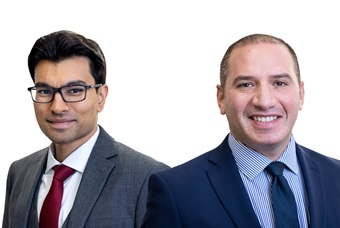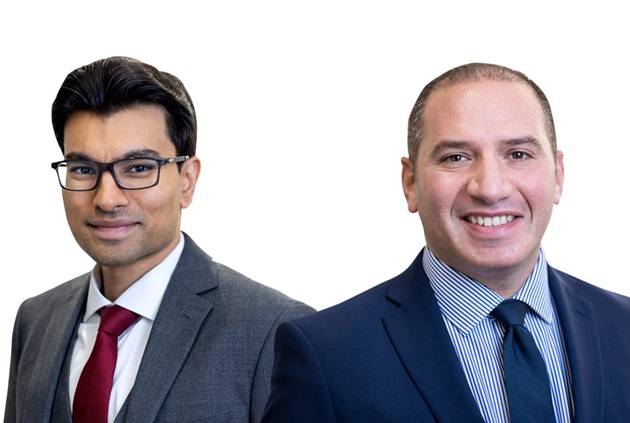Bunions and beyond: Leading the field in bespoke treatment
Once wide-fitting and soft shoes have served their purpose of accommodating bunions, surgery is often seen as a simple solution for patients suffering from this common condition. However, with significant recurrence rates and some patients reporting dissatisfaction after surgery, is the treatment for hallux valgus as straightforward as it seems?
Definitely not, according to one team of pioneering consultant surgeons. The Stanmore Foot and Ankle Specialists group (SFAS) is part of HCA Healthcare UK, based at the Outpatients and Diagnostic Centre on Devonshire Street in central London. Together, Mr Nicholas Cullen, Mr Matthew Welck, Mr Shelain Patel and Mr Karan Malhotra, have started to challenge the thinking around hallux valgus and, subsequently, the treatment of it.
“The bunion is something so common, it's taken for granted in many ways,” says Mr Malhotra, addressing the background to the group’s internationally acclaimed research. “But not all patients are happy. In fact, there's a surprisingly large number of patients who aren’t. We decided to look into why this might be and realised that there's a whole aspect to bunions and surgery that no one ever talks about.”




That aspect is rotation of the toe, something that had previously gone under the radar due to the limitations of traditional imaging techniques such as X-ray. Mr Malhotra explains further, “When you look down at a toe, you can see it’s bent, but what you can’t see is that sometimes it's also spun around. Part of the reason that's never been recognised is because the technology required to see it hasn’t been readily available.”
Internationally acclaimed research
The technology he’s referring to is weight-bearing CT (WBCT), which brings two key benefits into play. Firstly, unlike a two-dimensional X-ray, it shows the foot’s structure in three dimensions. Secondly, rather than a traditional CT scan, in which the patient is lying down, a WBCT gives consultants a true representation of the bones as they are when in use.
The consultants have been using WBCT for the best part of a decade, during which time they’ve managed to amass an impressive database of over 6,000 scans. This proved invaluable when it came to their research. In the space of a year, having identified rotation as a key issue, they had generated no fewer than six papers on the subject. The last of these, which looked at traditional surgery for bunions and found it failed to address rotational deformity, won the BOFAS 2022 Chang Cheng Memorial Prize for Best Clinical Paper.
Mr Welck picks up the thread, “One of the purposes of the surgery is to re-function the big toe,” he explains. “A surgeon might correct it and leave it looking nice and straight, but while it might be correct in one plane or in two planes, if it's still twisted, it's not working properly – and the toe may not be adequately re-functioned.”
The implications for patients left with this rotation post-surgery could be far-reaching. ”They may be a group of patients more likely to have recurrence,” he continues, “they may also be a group more likely to experience problems with the lesser toes, more likely to have ongoing pain or arthritis in this joint in the future.”
And it’s that future – and the potential impact this research could bring – that’s of particular interest to the team.
“It's a more prospective study going forward. We've done a lot of work defining the problem, but we still have some work to show how to improve outcomes.” And the HCA UK consultant team, it seems, are very much leading the way.
“Rather than offering a single treatment for a complex condition,” adds Mr Malhotra, “our goal is to offer every patient bespoke surgery, according to their individual needs.”
A pioneering approach
It’s a vision that extends to other areas of their practice as well. With the eyes of the clinical world on them, the team are making huge advances in bespoke treatment across the board with patient-specific instrumentation.
Their approach to wedge tarsectomy for midfoot deformity is a case in point. When carrying out an operation to correct a deformity of this kind, a surgeon will, typically, build in some tolerance to allow for a degree of human deviation when performing the cut. Thus the bid to restore function can occasionally lead to the sacrificing of a joint.
However, guided by their pioneering principle, the surgeons saw the chance to take approximation out of the equation altogether. “What we’re trying to do is make sure that what matters is the ability of a surgeon to plan, rather than how steady they can hold their hand in the moment.”
In order to do exactly that, the team use detailed scans of each patient to plan their operation down to the very finest detail. They work together closely with highly skilled manufacturing companies to produce an individual guide that the surgeons can follow.
“The guide is designed specifically to each patient, and fits precisely on their skeleton,” says Mr Malhotra. “Along with a special saw, it allows us to make the cut exactly where we planned, with no deviation and no human error.” And the results have been impressive to say the least.
“We operated on a 28-year-old with a complex pes cavus deformity [a high-arched foot that doesn’t flatten while weight-bearing],” continues Mr Malhotra. “We were able to do a cut exactly where we wanted in order to spare the joints. Our patient went from limping to walking 20,000 steps a day in the space of four months.”
That’s a big leap forward in every sense - taking someone with a complex deformity and planning their surgery in such detail that human error is effectively marginalised. The team are the first in the UK to adopt this approach for complex deformity correction and, with more research planned to quantify improved patient outcomes with these techniques, all eyes are on them as they lead the way into a new era of highly personalised procedures.